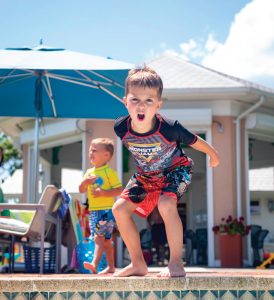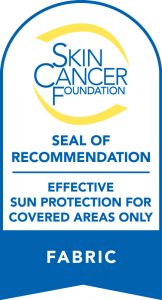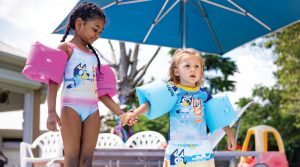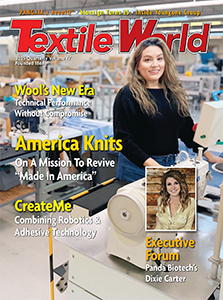
The Skin Cancer Foundation’s Seal of Recommendation presents an opportunity for apparel brands to expand within a growing market.
By Rachael S. Davis, Executive Editor
Much like smoking, sunbathing was once a widely embraced pastime — until science made it clear that prolonged exposure to ultraviolet (UV) rays significantly increases the risk of skin cancer. Today, as skin cancer rates continue to rise in the United States, fewer people view a deep tan as a badge of health or beauty. Instead, many are shifting their focus to sun safety, choosing sunscreen and protective apparel over products designed to darken the skin, and prioritizing long-term health over short-term aesthetics.
The Skin Cancer Foundation: Educating, Safeguarding
The Skin Cancer Foundation was founded in 1979 with the objective of empowering “people to take a proactive approach to daily sun protection and the early detection and treatment of skin cancer.” Through a variety of programs and resources, the foundation educates the public and the medical community about skin cancer and prevention methods. Its Photobiology Committee also sets minimum criteria needed to achieve The Skin Cancer Foundation’s Seal of Recommendation — a stamp of approval that may be earned by products that meet specifications “for safe and effective sun protection against the two types of UV radiation that have been directly linked to skin cancer: UVA and UVB.”
In 1981 when the program was created, a sun protection factor (SPF) of 15 was needed to achieve the Seal of Recommendation. The program was gradually expanded as different requirements were incorporated for a variety of products including textiles; and in 2005, the committee added standards for ultraviolet protection factor (UPF) covering sun-protective clothing, fabrics and outdoor fabrics used for umbrellas and awnings.
The Skin Cancer Foundation’s Photobiology Committee adapts the requirements based on the latest scientific evidence, and this year announced updated requirements for clothing. To earn the Seal today, fabric requires a minimum UPF of 50. Adult hats need a minimum 3-inch brim all the way around, while hats for babies and toddlers need a 2.5-inch brim.
“After extensive research and discussion, we made the unanimous decision to implement new sun protection standards for products that earn the Seal of Recommendation,” said Dr. Steven Q. Wang, director of Dermatologic Oncology, Hoag Family Cancer Institute, Hoag Memorial Hospital Presbyterian, and chair of The Skin Cancer Foundation Photobiology Committee.
“The Committee’s recommendations are always grounded in real-world science. The updated standards we are proposing have been tested over time and have already been adopted by many in the industry. We are committed to staying up to date in our recommendations for the public and are confident that these changes not only will help educate the public, but will guide them to choose products, that, when used consistently and as directed can help prevent skin cancer and save lives.”
Developing The UPF Testing Requirements
In 1998, the American Association of Textile Chemists and Colorists (AATCC) released Test Method 183 Transmittance or Blocking of Erythemally Weighted Ultraviolet Radiation Through Fabrics. This test method, considered the standard methodology for the measurement of UV transmission, has been reaffirmed and revised since its introduction and is the basis used for textile UV labeling.
To develop the test method and standards surrounding UV protection, AATCC Committee RA106 UV Protective Textiles Test Methods worked with the ASTM Subcommittee D13.65 UV Protective Fabrics and Clothing. Challenges considered included how to measure the blocking effectiveness of materials and finishes applied to textiles, the data needed to connect an instrument’s data to human exposure, and how to prepare a sample for testing, while also deciding if fabric should adhere to the existing SPF rating system used by sunscreens.
It was determined that to avoid confusion, a new rating system was warranted for fabrics and clothing when it came to UV protection claims and hence, the UPF standard was born.
The two ASTM committees involved in the discussions also developed two companion standards to the AATCC test method — ASTM D6544 Standard Practice for Preparation of Textiles Prior to Ultraviolet Transmission Testing and D6603 Standard Specification for Labeling of UV-Protective Textiles — which were both published in the mid-2000s.
Not Regulated Or Required
Fabric testing is not required by the government in any way but is required for products to earn the Seal of Recommendation. “Today, the Seal of Recommendation requires a mini-mum UPF of 50 for fabric,” said Dr. Wang. Spectrophotometers are used to measure the amount of UV radiation that penetrates a fabric to determine the UPF. Fabrics are also tested both wet and dry to ensure consistent protection in different use cases.
“If a fabric comes in multiple colors, we recommend testing the lightest shade to show that the entire range meets the minimum UPF requirement of 50,” Dr. Wang said. “A UPF 50 fabric blocks 98 percent of the sun’s rays and allows two percent— or 1/50th — to reach your skin.”
Dr. Wang also offered some additional advice when it comes to creating or choosing a fabric with sun protection in mind. “A tightly woven piece of fabric with smaller gaps between the yarns, like denim, offers more protection than a fabric with a looser, more open weave pattern,” he said. “Next, thicker and darker fabrics are more protective than thin, light-colored fabrics. For example, a bleached cotton offers little protection, whereas a black corduroy blocks more UV radiation.” Dr. Wang also offered that synthetic materials are better for UV protection than natural fibers; and chemical UV absorbers, whiteners or dyes may also improve a fabric’s UPF rating.

Educating Consumers
The Skin Cancer Foundation notes that its Seal of Recommendation is one of its most recognizable educational initiatives. In 2025, The Skin Cancer Foundation introduced a new design for the Seal featuring redesigned artwork with descriptive language to better educate consumers.
“When a fabric earns the Seal of Recommendation, we provide the brand with the Seal artwork and urge them to display it on the hangtag to help the public make educated and proactive decisions about the products they use to protect their skin,” said Becky Kamowitz, executive director of The Skin Cancer Foundation. “Over the program’s 40-year history, people have come to trust the Seal of Recommendation when they see it on a product because they know it has been medically reviewed by the physicians on our Photobiology Committee who have verified that the product provides safe and effective sun protection when used as directed.”
According to Dr. Wang, unlike the window film and sunscreen industries, there is little in the way of standardization or government oversight for testing and rating SPF fabric. “This is one reason why the Seal of Recommendation is so important in this market,” he said.
For a product to qualify for the Seal, the Photobiology Committee. comprised of board-certified dermatologists, reviews third-party laboratory testing data that is submitted by manufacturers.
“The number of applications we receive for the Seal of Recommendation increases each year,” Kamowitz reported. “The credibility that comes with earning the Seal of Recommendation is increasingly important as we monitor a growing amount of misinformation regarding sun protection circulating on social media,” she continued. “There is a sense of corporate responsibility for many of the companies that apply for review of their products and there is medically backed support for higher sun protection standards in this community. That said, there is always room for improvement. It’s important to continue to educate the apparel industry, and to remind brands that sun-protective fabric isn’t only for swimsuits and outdoor apparel.”
Growth Opportunity
Kamowitz also notes that while there is increasing consumer interest in sun-protective clothing and the market continues to grow, finding UPF-rated, sun-protective clothing can be a challenge for the public. “In 2024, the market size for nanotextiles — where UPF clothing is grouped — was estimated to be $14.8 billion — up $5 billion from 2019,” Kamowitz disclosed. “And Google search data shows a significant increase in the average number of times people search for the terms ‘sun-protective clothing,’ ‘UV-protective clothing,’ and ‘UPF clothing’ in the past two decades.”
Despite this data, availability at retail and online shopping for UPF apparel remains limited. “Less than 50 percent of retailers list UPF-rated clothing on their websites and those that do, offer a limited selection,” Kamowitz said. “Another constraint is that retailers and manufacturers don’t consistently promote that their garments have a UPF rating or are considered sun protective.”
Textile manufacturers have an opportunity to differentiate their products at retail by earning The Skin Cancer Foundation’s Seal of Recommendation. With awareness of the dangers of UV exposure, the Seal of Recommendation is a critical bridge between scientific rigor and consumer trust. By continually updating standards to reflect the latest research, the foundation not only guides manufacturers in creating truly protective products, but also empowers consumers to make informed choices. With public interest in sun-protective apparel on the rise yet availability still lagging, the opportunity for growth in the textile is clear — and so is the need for continued education, innovation, and transparency to ensure that effective sun protection becomes the norm rather than the exception.

Dreamwave: Stylish, Safe & Seal-Certified
Dreamwave LLC is a Bentex Group company based in New York City. The company has been a go-to resource for children’s swimwear for more than 20 years. Today, the company offers character licensed apparel — including Disney, Nickelodeon, Marvel and Mattel, among other licenses — and private label swim and loungewear to accounts that include Walmart, Target, Kohl’s and Costco. It works with retail customers to build a sales and design strategy for private label design, sourcing and manufacturing.
“We pride ourselves on product quality, product safety and exceeding consumer expectations,” said Joseph Grazi, e-commerce manager, Dreamwave. “Our production is out-sourced, however we maintain dedicated overseas offices for quality control and daily oversight, enabling us to stay closely involved in every stage of production.” In addition, all of Dreamwave’s manufacturing partners go through a vigorous third-party screening process.
UPF requirements are considered all the way from initial design through to final production. “We at Dreamwave take great pride in offering exceptional hand feel and sun-protective fabrics,” Grazi said. “While we continuously refine and enhance our offerings, we consistently maintain a minimum UPF rating of 50+. We have robust testing protocols that our factories adhere to so that we can ensure the fabrics comply with our standards.”
As a result of that dedication, Dreamwave products have earned The Skin Cancer Foundation’s Seal of Recommendation. For the most part, Dreamwave uses a combination of hangtags, stickers and online product descriptions to educate consumers about the UPF benefits of its products. “I believe Dreamwave having the Seal of Recommendation adds validity to our immense focus on sun protection,” Grazi said. “I hope our customers will recognize and appreciate this certificate and feel confident that their purchase is backed up by more than just a statement.”
2025 Quarterly Issue III




